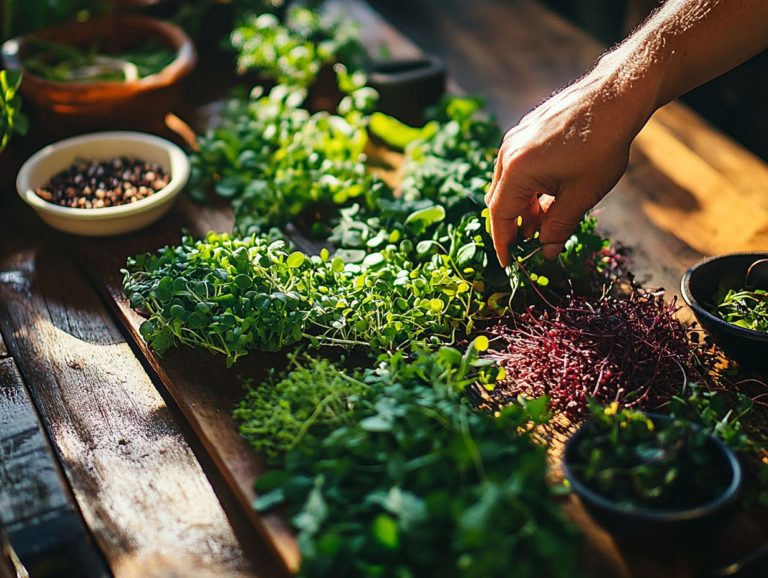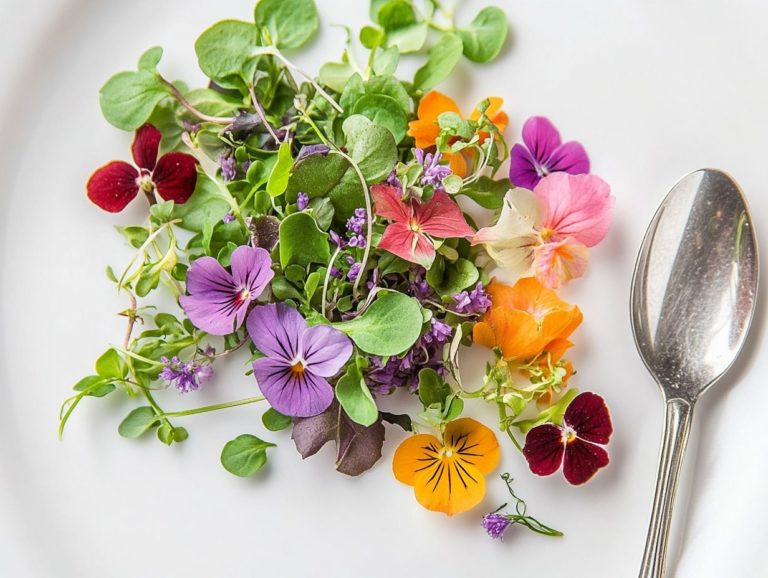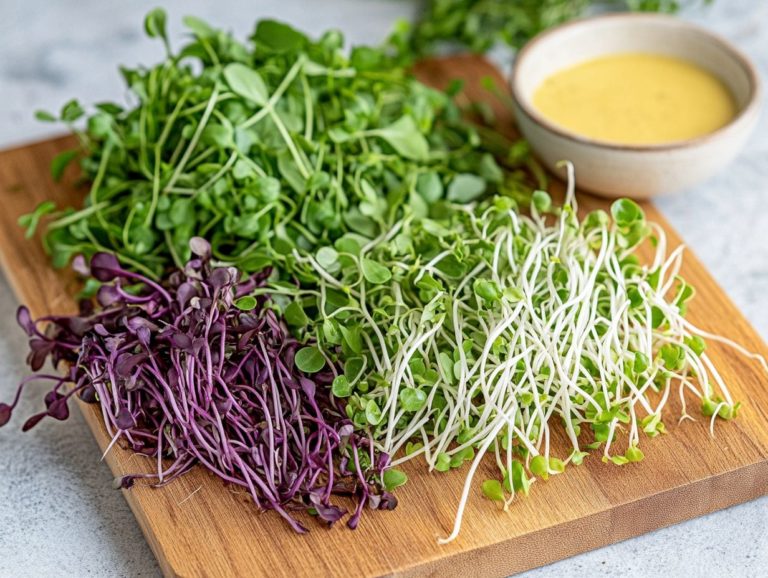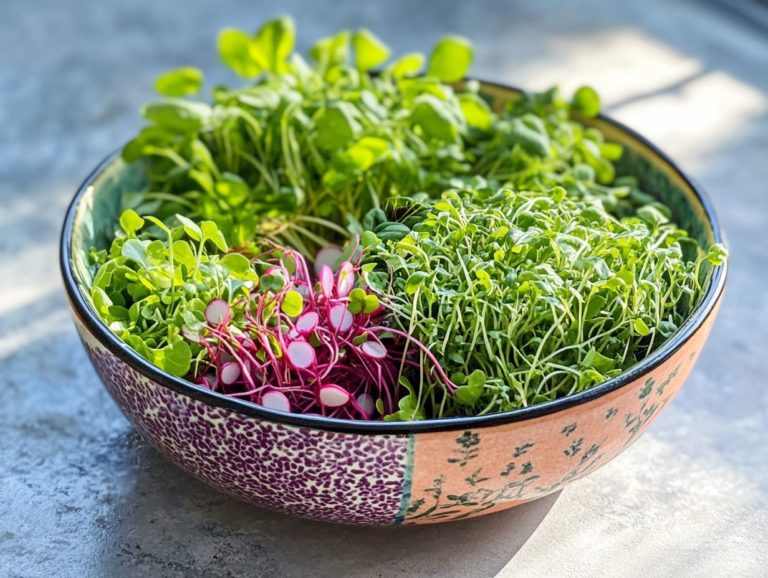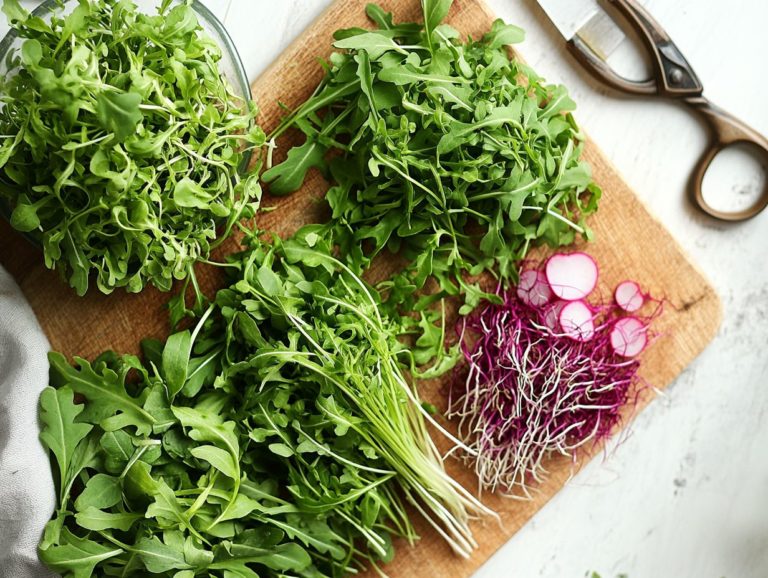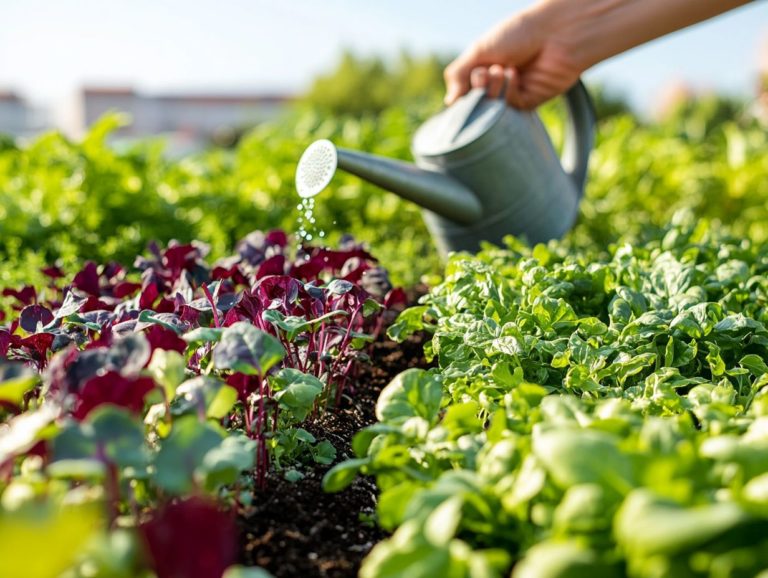5 Nutritious Microgreen Varieties for Smoothies
Microgreens are tiny powerhouses brimming with flavor, nutrients, and numerous health benefits.
This article explores the advantages of adding microgreens to your diet through delightful smoothies. You ll discover how easy it is to enhance your drinks with varieties like sunflower, pea shoots, and broccoli microgreens, each offering unique tastes and health perks.
Whether you love smoothies or want to boost your meals, this guide will inspire you to include these vibrant greens in your kitchen routine.
Contents
- Key Takeaways:
- 1. Nutritional Benefits of Microgreens
- 2. How to Incorporate Microgreens into Smoothies
- 3. Sunflower Microgreens
- 4. Pea Shoot Microgreens
- 5. Broccoli Microgreens
- 6. Radish Microgreens
- 7. Kale Microgreens
- 8. Cilantro Microgreens
- 9. Basil Microgreens
- 10. Mustard Microgreens
- 11. Arugula Microgreens
- 12. Wheatgrass Microgreens
- 13. Alfalfa Microgreens
- 14. Beet Microgreens
- 15. Chia Microgreens
- Frequently Asked Questions
- 1. Why should I add microgreens to my smoothies?
- 2. What are the top 5 nutritious microgreen varieties for smoothies?
- 3. How should I prepare microgreens before adding them to my smoothies?
- 4. Can I use frozen microgreens in my smoothies?
- 5. How do microgreens enhance the flavor of smoothies?
- 6. Can I grow my own microgreens at home for smoothies and culinary enhancement?
Key Takeaways:
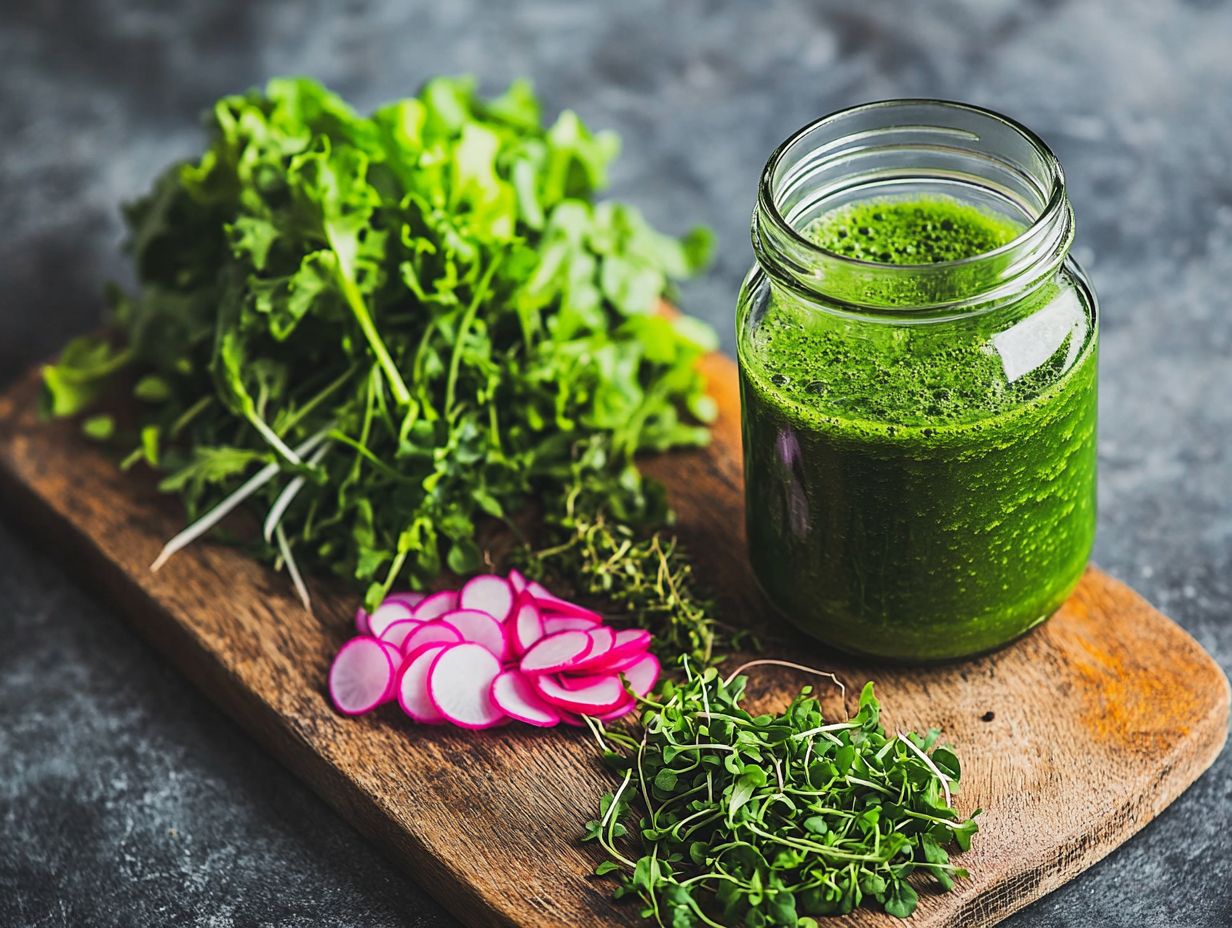
- Adding microgreens to smoothies is a simple and tasty way to boost nutrition.
- Sunflower, pea shoot, and broccoli microgreens are rich in vitamins and minerals, making them fantastic additions.
- Don t hesitate to try other varieties like kale, cilantro, and arugula for unique flavors and health benefits.
1. Nutritional Benefits of Microgreens
Microgreens deliver remarkable health benefits that far exceed their small size. These edible plants, like sunflower microgreens, pea shoots, and broccoli microgreens, are packed with vitamins, minerals, and antioxidants.
Loaded with essential nutrients such as Vitamins C, E, and K, they can enhance your immune system and support overall wellness. Their vibrant colors and fresh flavors brighten everything from salads to smoothies.
Growing microgreens at home is easy and requires minimal space. Harvest them as they sprout their first true leaves to capture their peak health benefits.
2. How to Incorporate Microgreens into Smoothies
Adding microgreens to your smoothies is a powerful way to boost your nutrition while enjoying vibrant flavors. Whether you choose nutrient-dense sunflower microgreens or the peppery notes of arugula, these greens can elevate your smoothie experience.
For a refreshing morning blend, mix radish microgreens with sweet fruits like strawberries or bananas. You ll enjoy a zesty kick that s sure to wow your taste buds!
It s key to balance flavor with nutrition, ensuring your smoothie is delicious and packed with vitamins. By experimenting with combinations, you open up endless creative possibilities for delightful, nourishing drinks.
3. Sunflower Microgreens
Sunflower microgreens are not just a feast for the eyes; they boast impressive nutritional content and health benefits. These microgreens are bursting with vitamins, minerals, and antioxidants. They enhance your dishes and add a delightful crunch that elevates every bite.
Loaded with protein and essential fatty acids, sunflower microgreens support muscle growth and promote heart health. They’re an excellent choice for anyone looking to improve their nutrition.
Growing sunflower microgreens at home is simple. Just soak the seeds for a few hours, plant them in nutrient-rich soil, water them well, and find a sunny spot for them to thrive.
Their versatility is impressive. You can toss them into salads, layer them in sandwiches, or use them as a vibrant garnish. They add flavor and a burst of color that transforms an ordinary meal into a culinary masterpiece. Sunflower microgreens are essential for anyone wanting to add a creative touch to their cooking.
4. Pea Shoot Microgreens
Pea shoot microgreens are your secret weapon in the kitchen. They are celebrated for their sweet flavor and vibrant green hue, effortlessly elevating salads, sandwiches, and smoothies.
These tiny greens are a powerhouse of nutrients, brimming with essential vitamins and antioxidants. They not only enhance your culinary experience but also deliver impressive health benefits.
Particularly noteworthy is their abundance of vitamins A, C, and K, which support vision, promote skin health, and aid in blood clotting. Their versatility shines as they pair beautifully with other fresh ingredients like avocados, nuts, and citrus, adding a refreshing crunch.
Growing pea shoots at home is a breeze. All you need are a few supplies seeds, soil, and a container. This makes it accessible for anyone eager to bring fresh produce into their meals.
5. Broccoli Microgreens
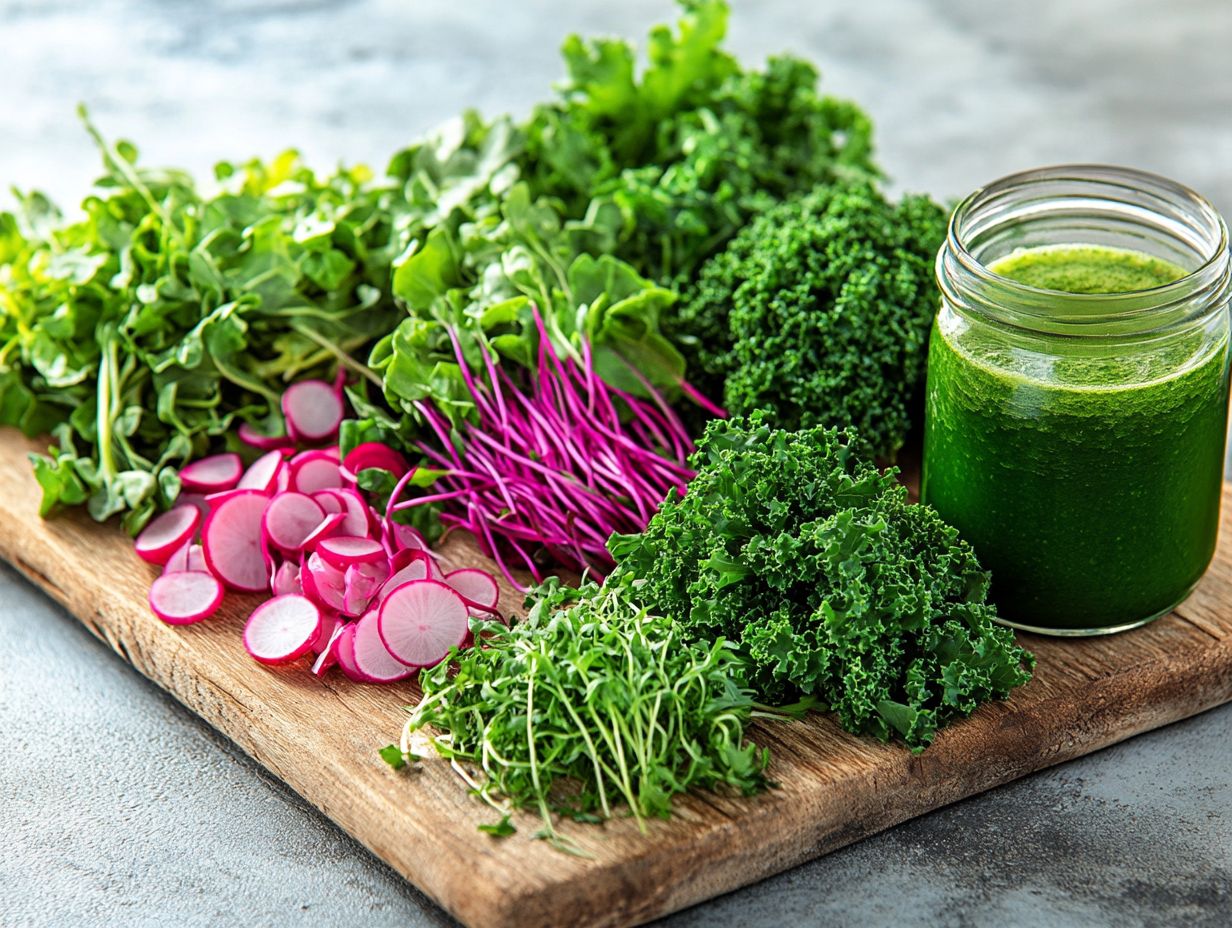
Broccoli microgreens rank among the most nutrient-dense varieties. They offer an impressive array of health benefits essential for any wellness-focused diet.
These greens are bursting with antioxidants and essential vitamins. Research shows they contain high concentrations of sulforaphane, a compound linked to cancer prevention and detoxification.
Incorporating them into your meals is easy. Just toss a handful into salads, blend them into smoothies, or use them as a vibrant garnish on soups and sandwiches.
Growing broccoli microgreens at home is straightforward and rewarding. They require minimal space and can thrive in just a week or two with the right care. Simply cut them above the soil line to enjoy their fresh, peppery flavor.
6. Radish Microgreens
Radish microgreens deliver a delightful peppery flavor that elevates a variety of dishes while offering impressive health benefits. These vibrant greens are packed with vitamins A, C, and E, making them a powerful ally in your kitchen.
When paired with ingredients like avocado or citrus fruits, they enhance the overall taste and create a delightful contrast that tantalizes the palate. Rich in antioxidants, radish microgreens support detoxification, promoting overall wellness.
Growing radish microgreens is easy! They thrive in well-drained soil and need minimal sunlight, perfect for any aspiring gardener. Harvest them at just a few inches in height to capture their maximum flavor and nutritional benefits.
7. Kale Microgreens
Kale microgreens are a compact version of this beloved vegetable. They offer unmatched nutritional value, making them perfect for your cooking and health.
These tiny greens are rich in vitamins K, A, and C. They add robust flavor and contribute to your overall wellness.
The high vitamin K content is vital for bone health. This helps reduce the risk of fractures and osteoporosis.
Incorporating these vibrant greens into your meals is easy. Toss them in salads, blend them into smoothies, or use them as a flavorful garnish.
Best of all, you can grow them at home in small containers. Fresh, nutritious options are easily within reach, even in limited space!
8. Cilantro Microgreens
Cilantro microgreens offer a delightful burst of flavor that is refreshing and aromatic. They make an exquisite addition to various global cuisines while boasting impressive nutritional benefits.
Rich in antioxidants and vitamins, these microgreens cater perfectly to wellness trends. Their vibrant green leaves transform everyday dishes like spicy tacos and crisp salads.
They add not just flavor but also visual appeal, elevating your entire meal. Beyond their culinary allure, cilantro microgreens support digestive health and contribute to detoxification.
If you’re looking to add these nutritious greens to your diet, consider growing cilantro microgreens at home. With just a bit of space and some seeds, you can enjoy fresh flavor right from your kitchen counter!
9. Basil Microgreens
Basil microgreens are a gem in the culinary world, celebrated for their aromatic flavor profile. They can elevate even the simplest dish into a culinary masterpiece.
Not only do they add a burst of flavor, but they also bring a wealth of health benefits and nutritional content to your table. Packed with essential oils and antioxidants, these tiny greens are a favorite among home cooks.
Their unique flavor balances sweet and peppery notes. This makes them a perfect addition to Italian, Asian, and Mediterranean cuisines.
Whether you re enhancing salads, soups, or sandwiches, basil microgreens not only elevate the taste but also provide anti-inflammatory properties that support your well-being.
To grow them effectively, choose a sunny spot and ensure well-drained soil. Harvesting is easy; simply snip above the soil with sharp scissors for a fresh supply of vibrant greens!
10. Mustard Microgreens

Mustard microgreens bring a sharp, peppery flavor profile that elevates many dishes. They offer a plethora of health benefits that resonate with health enthusiasts.
Rich in vitamins A, C, and K, these greens are an exceptional addition to salads and sandwiches. They shine in dressings, providing a zesty kick that can transform vinaigrettes or creamy blends.
Used as a garnish, these vibrant greens enhance the visual appeal of your plate while adding crunch and flavor. From a health perspective, they support heart health by potentially lowering cholesterol levels and improving circulation.
If you’re considering cultivation, mustard microgreens are a breeze to grow. They require minimal space and just a few days to harvest, making them perfect for seasoned gardeners and beginners alike.
11. Arugula Microgreens
Arugula microgreens have a unique peppery flavor that adds zest to your dishes. They are packed with vitamins C, K, and A to boost your meals’ nutrition.
These greens can enhance salads and gourmet pizzas. Wrap them in a tortilla for a tasty lunch.
Incorporating them daily can truly boost your health. Growing them at home is easy just find a sunny windowsill!
12. Wheatgrass Microgreens
Wheatgrass microgreens are known for their fantastic health benefits. They are packed with vitamins, minerals, and antioxidants.
These greens are full of chlorophyll, the green pigment in plants that helps detoxify your body. Add them to smoothies for a nutritious kick!
They grow well in minimal sunlight and well-drained soil. It’s easy to grow your own nutrient-rich greens at home.
13. Alfalfa Microgreens
Alfalfa microgreens are nutrient-rich and full of health benefits. They add protein and essential minerals to your diet.
Their mild flavor makes them great in salads, sandwiches, and smoothies. Growing them is simple just soak the seeds and spread them in soil.
In a week or two, you’ll have fresh greens to enhance your meals. Toss them into wraps for crunch, or blend them into smoothies for a health boost!
14. Beet Microgreens
Beet microgreens are colorful and packed with nutrients. They are low in carbs but high in vitamins and antioxidants.
These tiny greens support heart health and improve circulation. They’re rich in nitrates, which help increase blood flow.
Cultivating them is easy; sow seeds in well-draining soil and ensure they get plenty of light. For a refreshing boost, try adding the top 5 microgreens for smoothies to your salads or smoothies!
15. Chia Microgreens
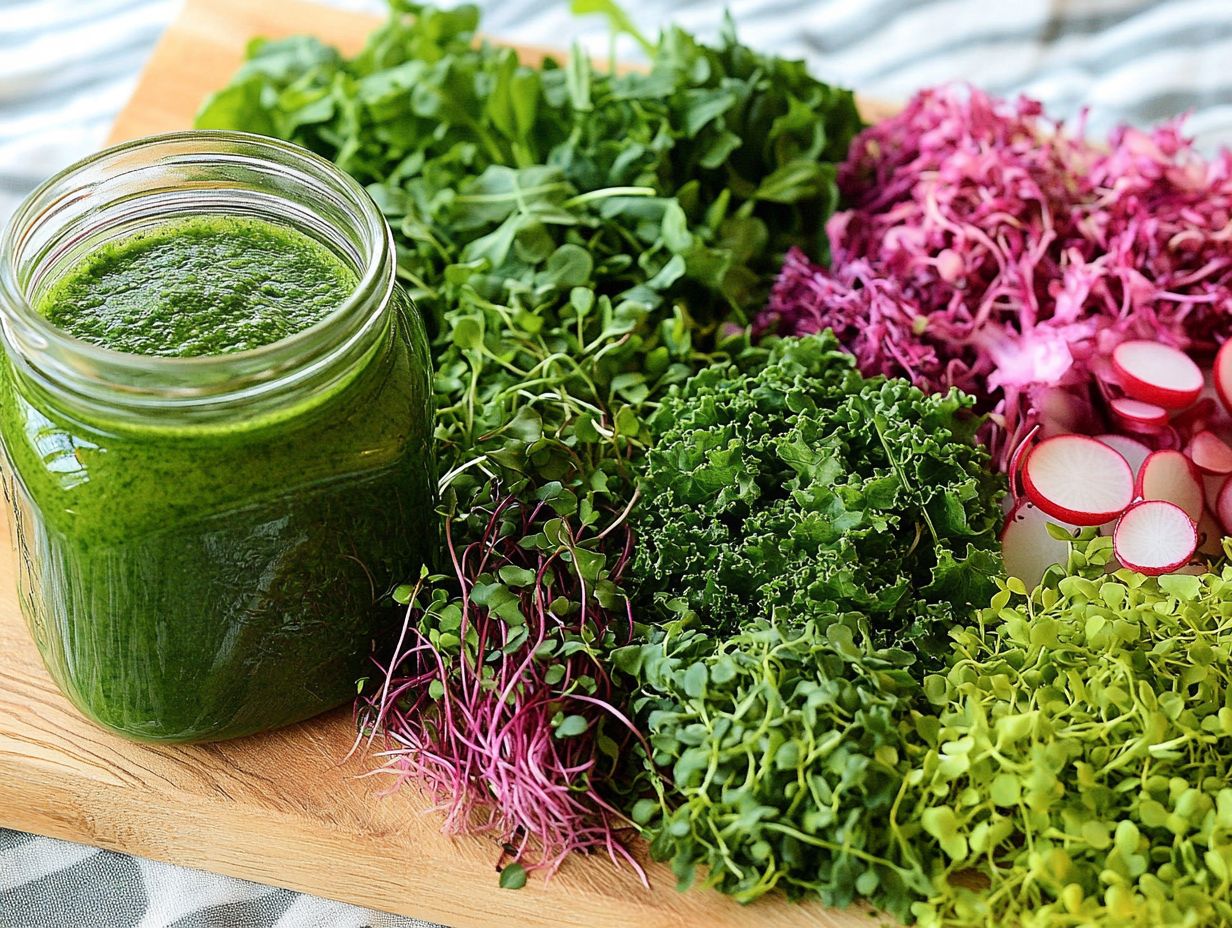
Chia microgreens are a powerhouse of nutrients, brimming with essential fatty acids and high protein content. They offer many health benefits and are an exceptional addition to any meal. With their subtle flavor and delightful crunch, these tiny greens appeal to both health enthusiasts and home cooks.
These microgreens are fantastic for heart health! Their rich omega-3 fatty acid content can help reduce inflammation and lower the risk of cardiovascular diseases. They are also a great source of dietary fiber, supporting healthy digestion and regularity.
Incorporating chia microgreens into your daily meals is a breeze. Toss them into salads, blend them into smoothies, or sprinkle them atop soup for an extra nutritional boost. If you’re inclined to grow your own, chia microgreens thrive indoors with minimal effort. Just grab a shallow container, quality soil, and some sunlight. For more information on different types, check out this quick guide to common microgreen varieties. With regular watering and proper drainage, you’ll have a nutritious crop ready in no time!
Frequently Asked Questions
1. Why should I add microgreens to my smoothies?
Microgreens are young, edible plants harvested just a few inches tall. They are packed with nutrients and considered a superfood because they contain high levels of vitamins, minerals, and antioxidants. Adding them to your smoothies can greatly boost their nutritional value.
2. What are the top 5 nutritious microgreen varieties for smoothies?
The top 5 nutritious microgreen varieties for smoothies are kale, broccoli, spinach, arugula, and pea shoots. These microgreens are rich in vitamins A, C, K, and E, as well as iron, calcium, and folate.
3. How should I prepare microgreens before adding them to my smoothies?
Wash microgreens thoroughly and pat them dry before adding them to your smoothies. You can also gently chop or tear them into smaller pieces to make blending easier.
4. Can I use frozen microgreens in my smoothies?
It is best to use fresh microgreens for maximum nutritional benefits. If you choose to use frozen microgreens, ensure they are properly thawed before adding them to your smoothie.
5. How do microgreens enhance the flavor of smoothies?
Incorporating garden cress into your smoothies can enhance hydration and add natural ingredients to your blends. These microgreens are versatile in flavor combinations and packed with nutrients, making them a sustainable choice for your diet.
Microgreens add a unique and delicious flavor to smoothies and juices, depending on the variety. For instance, kale and broccoli microgreens have a slightly bitter taste, while spinach and arugula have a milder, earthy flavor. If you’re looking for options with high nutritional value, consider exploring the best microgreens for nutritional value. Pea shoots contribute a slightly sweet and nutty taste.
6. Can I grow my own microgreens at home for smoothies and culinary enhancement?
Yes! You can easily grow your own microgreens at home for smoothies. These easy-to-grow greens thrive with proper care. All you need is a small tray, potting soil, and your choice of microgreen seeds. Grow them in a sunny window or under a grow light, using hydroponics or vertical farming techniques, and they will be ready for quick harvest in just a few weeks!

